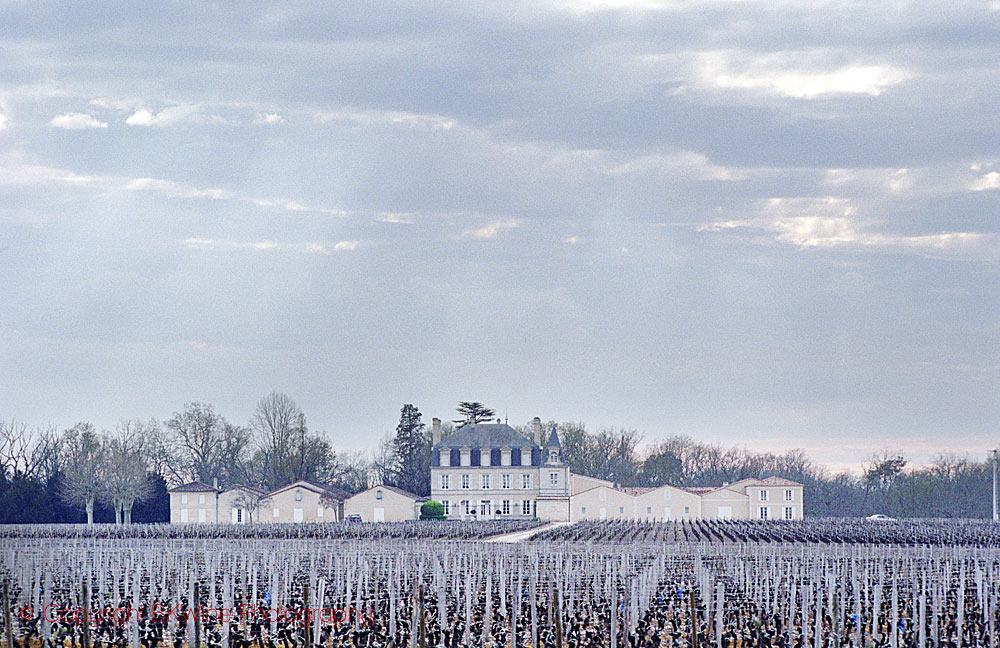Exclusive distillate at exclusive prices
Among the most exclusive of whiskies is the Dalmore Constellation Collection. It is a series of vintage whiskies created by the legendary Master Blender Richard “The Nose” Paterson. The entire collection contains 21 different whiskies back to 1964, priced from about 2000 euro to some 20,000 euro. Per bottle. Richard Paterson was recently in Stockholm to present this one of his life’s work. BKWine’s Roland Eriksson met with Paterson and tasted the distillates.
The Dalmore Distillery was founded in 1839 by Alexander Matheson and is located at the bay of Cromarty Firth in the Highlands area with a great view of the Black Isles with towering mountains in the background. In 1886 the Mackenzie family bought the distillery. Production and sales went well especially when Europe’s vineyards were devastated by phylloxera and whisky began to replace cognac and brandy distillates.
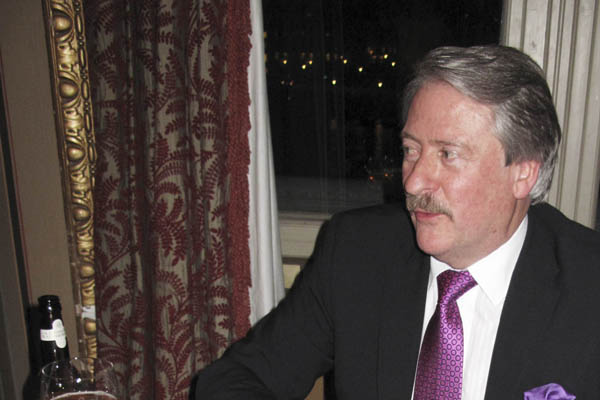
The 1900s began with some adversity. In July 1911 a fierce fire destroyed almost the entire stock. A few years later the First World War broke out (1914-1918) and thus it became more important to make bread instead of burning spirit of the same raw material. In 1917, the U.S. Navy used the premises as mine making factory. Production did not resume again until 1922.
In 1960 Dalmore Distillery merged with Whyte & Mackay, which is the present owner. The red deer head that adorns Dalmores bottles is the Mackenzies family coat of arms that they received, along with large estates, when a former relative saved the life of the Scottish King Alexander III who was attacked by a deer in 1263.
Long ago a boy was born; both grandfather and father traded in whisky. When he was 8 years old his father took him and his twin brother with to the wet and cold warehouses of Scotland (what would the Swedish social services say about that today?). There, his father taught him to talk about all scents and flavours of whisky: “think of your candy bar, think of the honey jar, the heather on the moor, a ripe peach, and think of your grandfather what power he has!” And when Richard said he did not feel anything in particular he had an (gentle) slap.
Today, 63 years later, Richard Paterson is a big name in the whisky industry with both titles Master Blender and Master Distiller and nicknamed “The Nose”. Richard has primary responsibility for White & Mackey’s entire production of single malts and blended whiskies. And his sensitive nose is insured by Lloyds of London for 1.5 million pounds!
Every distillery in Scotland has a small stock of older distillates. Normally a distillate from seed / grain cannot handle aging in barrels longer than 12-20 years before they become too “woody”. Unlike a wine distillate from the district of Grand Champagne Cognac which is considered best after 40-60 years in barrels. Usually distilleries produce a 12 years and in rare cases 18, 21 or 25 years old single malt whiskies, but the bulk of the production is sold on to become a blended whisky.
But Richard Paterson had a dream: he wanted to browse among all older barrels at Dalmore and selecting the very best that he then gave a finishing ageing in barrels that have contained 30 year old sherry, marsala, bourbon, or Bordeaux wine. He emphasized all along that “Cask is King” and that American or European oak has the greatest importance for the final result.
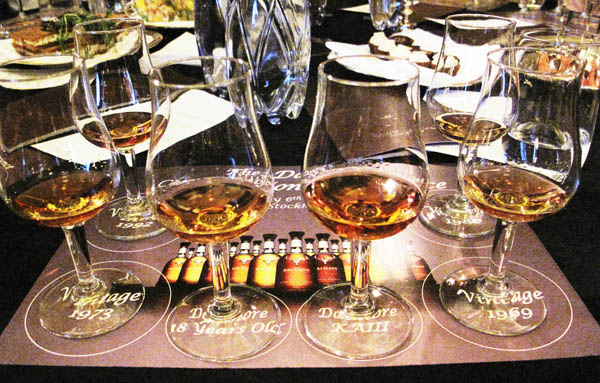
Richard likes to compares top-quality whisky with exclusive wines as Chateau Lafite and burgundy wines from DRC (Domaine de la Romanée Conti) and thinks that they may cost just as much. It all resulted in the Dalmore Constellation Collection when in 2012 21 vintages of Single Cask whiskies from 1964 to 1992 were launched in a limited edition.
Richard stresses that he is glad that for the first time he has the opportunity to present a part of the collection for us in Stockholm. He believes that Sweden is a very important whisky country. 35% of visitors to Scotland’s distilleries are from Sweden!
All bottles are mouth-blown crystal, hand engraved with decoration in real silver. The whiskies have no colouring, no cold filtration and all are bottled at natural strength, i.e. that which remains after long ageing.
Richard is an amazing speaker and showman. He kept on for over an hour with only a few breaks for some short films and he pointed out all the time how important it was to taste and smells. Take a small splash of whisky and let it wash around in the glass, pour out and refill with new and smell, smell, smell and take a little taste as you slowly roll around in the mouth for 15-20 seconds and then think of all that you experience.
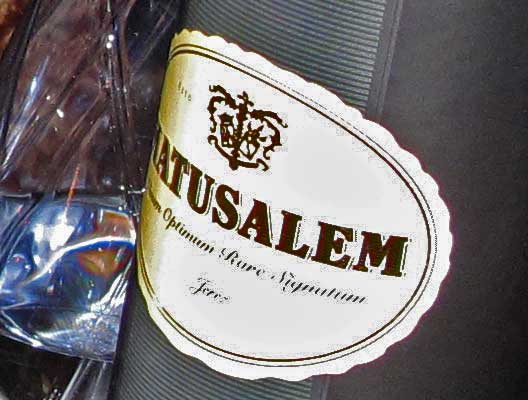
He told me what an American customer said when he asked about what he thought of the whisky? The response was “delicious”! But what about smell? “Outstanding”! Sigh … can’t you say anything more? No, why? I think it’s great!
And really, you may not need to get more complicated than that in a tasting? Everyone thinks and feels different so we will start with some of the “normal renditions” that Arcus (the importer) sells in Sweden.
Dalmore 18 Years Old
Aged 14 years in American oak and then 4 years in sherry casks, 43% vol, ~160 euro ( (*) approximate retail price in Sweden), 70cl.
Amber ; big powerful aroma, with hints of dark chocolate, orange peel, fruit notes, vanilla and barrel; the taste is rich, somewhat astringent, dry, with a lot of dried fruit, chocolate, cinnamon, orange marmalade and allspice ; long, 89p.
Dalmore King Alexander III (distilled in 1992)
Matured in casks that previously held sherry, port wine, burgundy, madeira, marsala and bourbon whiskey, 40% vol, 180 euro (*), 70cl.
Mahogany colour; very intense and sweet aroma, with hints of ripe raspberry, vanilla, tropical fruit and a marked barrel character; the taste is full-bodied, with hints of marzipan, vanilla, barrel, raspberry, ripe plum ; an intense fruitiness, long, 91p.
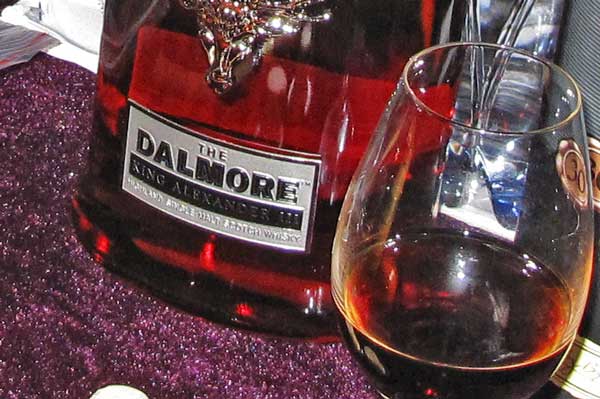
Dalmore Constellation Collection
Dalmore Vintage 1992 (19 years) Cask No.18
Matured for 14 years in first fill bourbon whiskey barrels, and then 5 years on port barrels, 773 bottles, 53.8 % vol, approximately 2400 euro, 70cl.
Mahogany colour ; very intense aroma, with rancio (hints of volatile acidity from long barrel aging), marzipan, ripe pears, herbs and ripe plums ; the taste is full-bodied, dry, spicy, with ripe pear, dried fruit, dark tobacco, barrels and a small residual sweetness ; long, 92p.
Dalmore Vintage 1980 (31 years) Cask No.495
Matured for 31 years in Apostoles oloroso sherry casks, 227 bottles, 52.1% vol, approximately 4800 euro, 70cl.
Dark mahogany colour; very intense aroma, with hints of dark chocolate, plum, dried fruit, raisins, vanilla and barrel; the taste is rich, vinous, with hints of plum, dried fruit, raspberry, slightly burnt tone and a hint of cumin; long, 92p.
Dalmore Vintage 1973 (38 years) Cask No.10
Aged 32 years in barrels of American white oak, then 3 years in cabernet sauvignon barrels of French oak, and then 3 years in “small batch” bourbon whiskey barrels, 223 bottles, 48.1% vol, approximately 13,500 euro, 70cl.
Dark amber colour; big, spicy, slightly smoky aroma with hints of orange marmalade, vanilla, rancio and pear fruit; the taste is very full-bodied, dry, some astringency, spicy, with hints of almond, ripe apples, wild raspberries and violet pastilles ; very long, 94p.
Dalmore Vintage 1969 (42 years) Cask No.14
Aged 36 years in barrels of American white oak, then 4 years in barrels that have contained 30 year old Matusalem oloroso sherry, and then 2 years in bourbon whiskey barrels, 233 bottles, 45.5% vol, approximately 18,000 euro, 70cl.
Amber ; very intense and quite sweet aroma, with hints of vanilla, milk chocolate, ripe pears, fruity and a lot of barrels; the taste is big, full-bodied and quite astringent, with hints of cinnamon, nutmeg, cedar, wild raspberries, an intense fruitiness, a cigar flavour and very long, 96p.
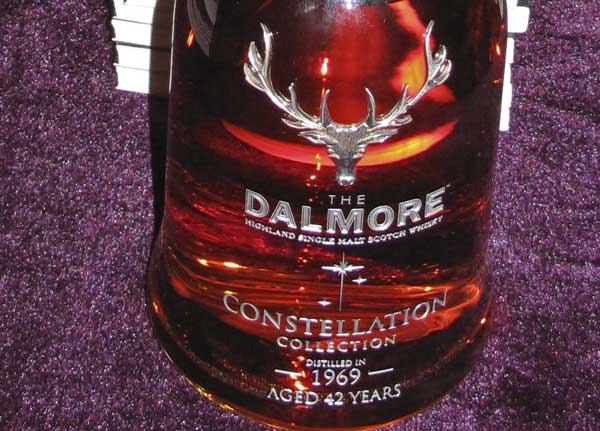
A very interesting tasting of top class whisky. The barrel ageing means that each variety has its own character. But the prices! The bottles cost a small fortune. Would I feel a bit “wealthy” someday, I might think of buying a bottle of King Alexander III, which is almost as good as the more expensive series but at a tenth of the price of a bottle of Vintage 1992. So either you have to make really a lot of money, or do as the Swedish parliament politician with over a hundred thousand euros in annual salary, shoplift a bottle at the monopoly!
The tasting was organised by wine & spirits importer Arcus Sweden AB and Zap PR.
Roland Eriksson writes on BKWine Magazine on wine tastings with wine merchants and importers in Sweden. Roland is the author of a book on cognac (A Handbook: Cognac, 2007, published in Swedish) and one on rum as well as one on tea.


